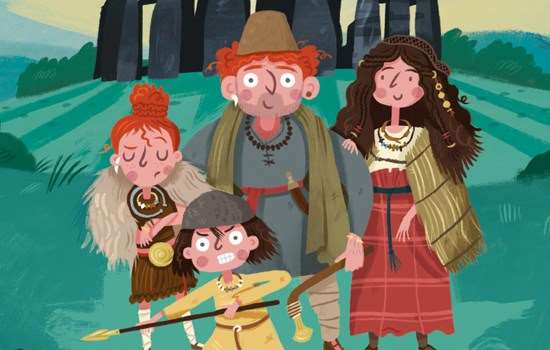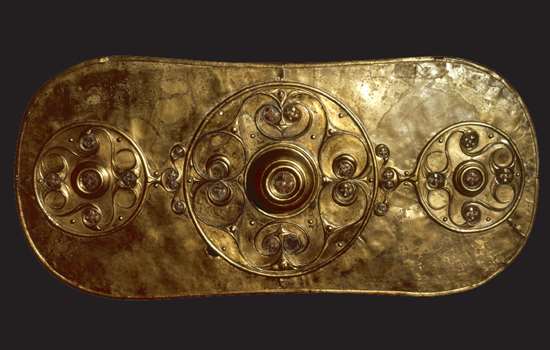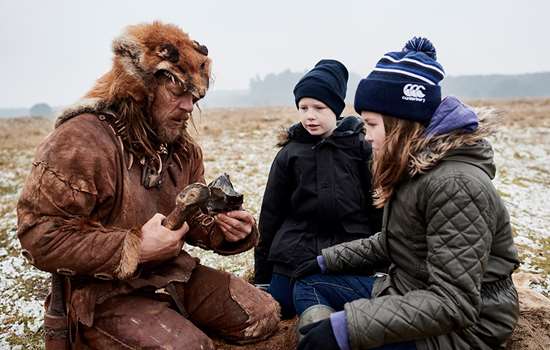VIDEO: MEET A BRONZE AGE SETTLER
M: Why is it so smoky in here?
We keep our fire burning all the time. It keeps us warm and stops the roof from getting too damp. The hearth means we can keep a pot above it too, so we can cook our food.
M: Where are the rooms?
We don’t have rooms. We don’t have servants or animals in here, we live together as a family.
K: Where do you go to the toilet?
In a pot, of course. Then we empty it into a ditch well away from our home – as it can be smelly!
M: How did you build your house?
We had tools to use, from axes to gouges. A lot of our tools are made from bronze, which is a mix of copper and tin. These metals are mined in places such as Wales and Cornwall.
K: What is the house made of?
Our roof is thatched, which means it’s made of reeds from the nearby river. We have wood from ash trees that form the poles, and from hazel trees for the walls. We keep a healthy supply of local trees, so we can be positive we have enough wood to build the next house and the next…
What is a roundhouse?
People in the British Isles lived in roundhouses for more than 2,000 years. The first ones were built in the Bronze Age, which started around 2300BC. They were also lived in throughout the Iron Age, which began in around 800BC and lasted until the Romans invaded in AD43. Roundhouses were still used after the Romans arrived.
Roundhouses were circular dwellings that had thatched roofs and walls made of wooden posts, which were filled in with wattle-and-daub (a combination of woven branches, earth and clay). The posts were placed in holes dug into the ground. Some roundhouses in upland areas were built with stone walls.
Roundhouses were often grouped into villages, such as Grimspound in Devon (which dates from the late Bronze Age), where there are the remains of 24 stone roundhouses. These were inside a huge boundary wall that was about 150 metres in diameter.
Building a roundhouse required great expertise, and would have taken many skilled workers a number of weeks to finish. They varied in size – from less than five metres in diameter to over 15 metres. Stone roundhouses were usually smaller. By the Iron Age, roundhouses were often quite large, suggesting that a lot of people were living together under the same roof.
The roundhouse that has been reconstructed at Beeston Castle and Woodland Park in Cheshire is based on evidence from the site that suggests bronze metal workers lived there during the Bronze Age. You can also see five reconstructed houses at Stonehenge in Wiltshire, which are based on the remains of Neolithic houses dating from approximately 2500BC.
MAKE YOUR OWN BRONZE AGE ROUNDHOUSE
Now make your own mini model of a Bronze Age roundhouse. Ask an adult to download the template and print it out, then just follow the instructions below to complete the roundhouse.
Once you’ve finished it, put your model Bronze Age dwelling on display to impress your friends!
DOWNLOAD THE TEMPLATEHOW TO MAKE YOUR ROUNDHOUSE MODEL
YOU WILL NEED:
- Your downloadable template
- Scissors
- Glue stick or double-sided tape
-

Step 1
Print the roof and roundhouse walls, then carefully cut both pieces out (or ask a grown-up to help you).
-

Step 2
Put glue or double sided tape along the tab on the roof, then fold round and stick it to create a cone shape. The wooden struts go at the back of the roundhouse.
-

Step 3
Loop the walls of the roundhouse, and stick together at the back.
-

Step 4
Put glue on the top three tabs of the roundhouse wall and glue to the inside of the roof, positioning the fire at the front of the roundhouse, where the roof curves upwards.



